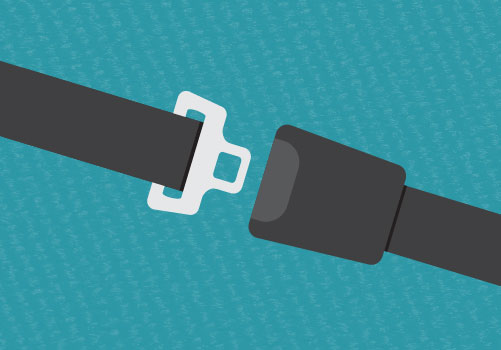
According to the latest Insurance Institute for Highway Safety report, at least 35% of the truck drivers who died in crashes were not wearing a seat belt.
This article is from the Fall 2016 issue of The Quill. To view the full issue, visit The Quill archive.
Effective Aug. 8, 2016, the Federal Motor Carrier Safety Administration (FMCSA) will hold motor carriers and drivers responsible for ensuring that passengers in commercial motor vehicles properly use seat belts.
This modification to the current rules regarding seat belt use offers fleet safety professionals an opportunity to promote and require seat belt use for all occupants of a vehicle. According to research conducted by the National Highway Traffic Safety Administration (NHTSA), 37 unrestrained passengers traveling in the cabs of large trucks were killed in roadway collisions in 2014. One-third of these occupants were ejected from the cab of the truck. As well as keeping occupants inside the vehicle, a restrained driver can maintain better vehicle control and therefore cause less damage in the event of a collision.
For several years, motor vehicle crashes have been the leading cause of occupational fatalities in the U.S. and accounted for approximately 25% of workplace deaths. Of these deaths, almost half were truck drivers. This in turn equates to 65% of all truck driver deaths being the result of a vehicle crash. According to the latest Insurance Institute for Highway Safety report, at least 35% of the truck drivers who died in crashes were not wearing a seat belt.
Based on the most recent FMCSA research, a record 84% of drivers now wear their belts whenever they are operating trucks on public roadways. While that is a worthy accomplishment for the industry, it implies that 16% of drivers still do not take this important, yet simple, step every time they drive to ensure both their safety and the safety of others on the roadway. The report also noted that 6% of drivers surveyed for the report indicated that they never use a seat belt, and that only 73% of commercial motor vehicle passengers use seat belts.
In a report by the Centers for Disease Control and Prevention, one finding was that behavior associated with not wearing a seat belt was correlated with a driver’s willingness to participate in other illegal or dangerous behaviors behind the wheel. Of the drivers that were found to not wear seat belts, many also reported driving more than 10 mph over the speed limit frequently, as well as having two or more moving violations in the past 12 months. Non-seat belt wearing drivers also indicated they worked for a company with no written safety program.
One demographic of truck drivers found to be closely associated with not always wearing a seat belt were women. The CDC report stated that women and shorter drivers were most closely associated with being uncomfortable when wearing a seat belt. Drivers with pacemakers also reported discomfort when wearing seat belts.
The FMCSA considers the use of seat belts important and has taken several steps to encourage their use. As part of the safety regulations, seat belt violations are considered important enough to warrant a severity weight of seven in calculating CSA BASIC scores. Fleets struggling to keep their BASIC scores low might take a look at the frequency of these violations and take steps to encourage compliance.
So what are some steps that a fleet can take to encourage seat belt use by drivers and passengers? One simple solution is to take advantage of the resources offered by an FMCSA outreach program. The CMV Safety Belt Partnership is a collaboration between the U.S. Department of Transportation’s Federal Motor Carrier Safety Administration, other government agencies and industry-specific, private-sector organizations designed to encourage safety belt use by commercial motor vehicle drivers. Another important step in ensuring seat belt usage is having a formal, written safety policy or program in place. Giving recognition or incentives to those drivers who do wear seat belts regularly, as well as ensure their passengers wear seat belts, can also help to ensure more drivers are adhering to this lifesaving practice.